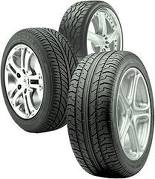Get the “Accurate” Tire
Replacement, Rotation and Alignment!

How do you know
if you need new tires?
Tire wear depends on several factors, including your driving style and
tire maintenance habits. Wrong size load and speed rating can void your
warranty. But one sure way to know when to replace your tires is when
treadwear indicators appear. A tire's built-in treadwear indicators
are "wear bars" that looks like narrow strips of smooth rubber
across the tread and appear when it's time to replace the tire.
You also need a new tire if:
You can see three or more treadwear indicators around the tire
Cord or fabric is showing through the rubber
The tread or sidewall is cracked, cut or snagged deep enough to show
cord or fabric
The tire has a bulge or split
The tire has a puncture, cut, or other damage that can't be repaired
correctly
Tire Pressure
Maximize your tires' performance and durability by monitoring and maintaining
correct air pressure.
Air is a gas, expanding when heated and contracting
when cooled. For most of North America, fall and early winter are especially
important times for checking tire pressure – as the ambient temperature
falls, tire pressure goes down.
A good rule of thumb is that every 10 degrees
Fahrenheit temperature change, tire pressure changes about 1 psi – higher
as temperature rise, lower as they fall. Also, check your vehicle's
Owner's Manual for recommended tire pressure.
Under-inflated tires can cause:
Premature or irregular wear
Poor handling
Reduced fuel economy
Over-inflated tires can cause:
Unusual wear
Poor handling
Reduced fuel economy
Checking Air Pressure
Check your vehicle's tires at least once a month, when the tires are
cold (let the vehicle sit for at least 3 hours). Look in your owner's
manual for the recommended tire inflation for your vehicle. Use a quality
gauge. Don't "eyeball" tires – radial tires can look fine
even when they're under-inflated.
Be sure to look for objects that have become
wedged in the tread – they can work themselves further into the tire
and cause air loss.
And don't forget to check the spare!
Tire Rotation
Since each tire performs different tasks (such as steering or front
versus rear wheel drive), tires wear at different rates. Rotating your
tires at recommended intervals extends their useful life and achieves
more uniform tire wear.
It's important to rotate your tires according
to the correct tire rotation pattern. Front tires encounter different
tasks than the rear tires. And a front-wheel-drive car's tires perform
different tasks than those on a rear-wheel-drive car. Your owner's manual
specifies which rotation pattern is right for your vehicle.
Your vehicle's front and rear tires may also
use different pressures – make sure to adjust individual tire pressure
to the recommendation for each wheel position. See your Owner's Manual
for recommendations.
Wheel Rust or Dirt
Rust or dirt may not allow proper tightening of the lug nuts and a wheel
may loosen over time. When you have your tires rotated, be sure to remove
any rust or dirt from places where the wheel attaches to the vehicle
and torque the wheel lug nuts to the specification in your Owner's Manual.
In an emergency, you can use a cloth or paper towel, but be sure to
use a scraper or wire brush later to remove all rust or dirt and torque
to specifications.
Also, remember that rotating your tires won't
correct wear problems caused by worn mechanical parts or incorrect inflation
pressures.
Wheel Alignment & Tire Balance
Scheduled alignment and balancing are not needed, since your vehicle's
wheels were aligned and balanced at the factory. But if you notice unusual
tire wear or that your vehicle "pulls" one way or the other,
the wheel alignment may need to be reset. If you notice your vehicle
vibrating on a smooth road, your wheels may be out of balance.
A tire that is out of balance often affects ride
quality and can shorten the life of tires, bearings, shocks, and other
suspension components. A speed-dependent vibration – becoming noticeable
around 45 mph and increasing as speed increases – is probably balance-related.
Tire Alignment
Alignment is critical for ensuring that you get maximum wear and performance
from your tires. Poor alignment results from your car's suspension and
steering system becoming out of adjustment with each other. The biggest
indicators of your vehicle being out of alignment are a "pulling"
one way or the other as you drive or unusual tire wear. Improper tire
inflation can also cause unusual tire wear.
Your Vehicle may have both front and rear wheel
alignment specifications. Our experrts can recommend the alignment type
that's right for your vehicle.
Call and ask about our
current Tire Service Special going on for the Month of February!
(617)364-7430